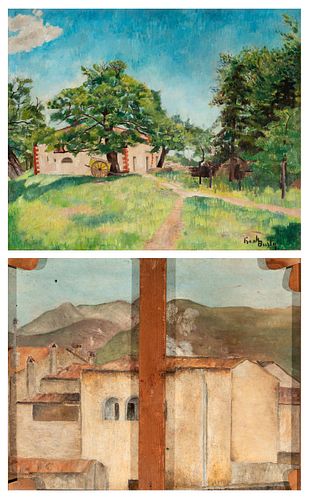FRANK BURTY HAVILAND (Limoges, 1886 - Perpignan, 1971). "Mansion" and "Houses of Ceret". Oil on canvas, painted on both sides.
Lot 45
About Seller
Setdart Auction House
Carrer Aragó 346
Barcelona
Spain
Setdart Subastas was born in 2004 and is currently the first online art auction in Spain with solidity, prestige and reliability guaranteed by our more than 60,000 users. Setdart has a young, dynamic and enterprising team ready to successfully manage the purchase and sale of art works through custom...Read more
Estimate:
EUR€4,000 - EUR€5,000
$4,210.53 - $5,263.16
Absentee vs Live bid
Two ways to bid:
- Leave a max absentee bid and the platform will bid on your behalf up to your maximum bid during the live auction.
- Bid live during the auction and your bids will be submitted real-time to the auctioneer.
Bid Increments
| Price | Bid Increment |
|---|---|
| EUR€0 | EUR€10 |
| EUR€200 | EUR€25 |
| EUR€500 | EUR€50 |
| EUR€1,000 | EUR€100 |
| EUR€3,000 | EUR€200 |
| EUR€5,000 | EUR€500 |
| EUR€10,000 | EUR€1,000 |
| EUR€20,000 | EUR€2,000 |
| EUR€50,000 | EUR€5,000 |
About Auction
By Setdart Auction House
Oct 27, 2021
Set Reminder
2021-10-27 10:00:00
2021-10-27 10:00:00
America/New_York
Bidsquare
Bidsquare : 19th & 20th Century Paintings & Decorative Arts
https://www.bidsquare.com/auctions/setdart-auction-house/19th-20th-century-paintings-decorative-arts-7767
Setdart Auction House sofia@setdart.com
Setdart Auction House sofia@setdart.com
- Lot Description
FRANK BURTY HAVILAND (Limoges, 1886 - Perpignan, 1971). "Mansion" and "Houses of Ceret". Oil on canvas, painted on both sides. Signed in the lower right corner. Measurements: 50 x 61 cm. This canvas, painted on both sides, shows places near the place where Frank Burty resided and contributed to turn it into a neuralgic center of the cubist creation: we can recognize the typical houses of Ceret in one of the paintings. These works probably correspond to an advanced stage of Burty's life, when he had already moved away from avant-garde work to return to a more traditional and intimate figuration. Frank Burty was a French cubist painter, a friend of Picasso and Braque, and one of the first collectors of African art. He was the grandson of Philippe Burty, collector and art critic who coined the term "Japonisme". His brother, Paul Haviland, was a photographer and writer. Burty studied music with Ricardo Viñes, and through him met De Séverac and Manolo Hugué, who in turn introduced him to the group of Cubist painters in Paris. In 1910, Burty went to the south of France with Manolo and De Séverac, and bought a monastery in Céret, in the French Pyrenees, which became the center of the so-called School of Céret until 1914. Some of the most important painters of the time participated in it, with Pablo Picasso, Juan Gris, Georges Braque, Max Jacob and Auguste Herbin. Burty was portrayed by Amedeo Modigliani in 1914, and is probably also the model in Juan Gris' The Smoker, 1913. His bust was also immortalized by his friend Manolo Hugué. In April 1914, he had a solo exhibition at Alfred Stieglitz's gallery 291. In 1915, his work was included in the first exhibition at Marius de Zayas' Modern Gallery in New York, along with works by Picasso, Braque, de Zayas, Francis Picabia and others. His work was also included in exhibitions at that gallery during the following years. In November 1917, Burty had a solo exhibition at the Dalmau Galleries in Barcelona, and in 1921 he exhibited at the Brummer Gallery in New York. His later style was more classical, moving away from the cubism of his early years. Burty lived most of his life in Céret and was one of the driving forces behind the creation of the Céret Museum of Modern Art in 1950, which he helped to acquire 14 works by Henri Matisse and more than 50 works by Picasso. He was curator of the museum from 1957 to 1961. When the museum acquired Burty's archive, which included 83 paintings and more than 700 drawings, in 2008, it organized a retrospective exhibition on him from December 5, 2009 to May 30, 2010.
- Shipping Info
-
In-house shipping available. Please inquire at admin@setdart.com.
-
- Buyer's Premium



 EUR
EUR CAD
CAD AUD
AUD GBP
GBP MXN
MXN HKD
HKD CNY
CNY MYR
MYR SEK
SEK SGD
SGD CHF
CHF THB
THB
















